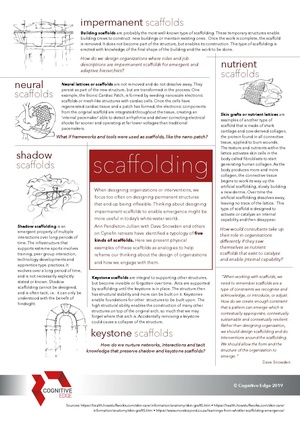Scaffolding
| “ | [A scaffold is] a temporary structure for supporting something until that something is able to stand on its own | ” |
| — Ann Pendelton-Jullian (2018) | ||
Scaffolding is both a noun and a verb, a structure and a process - an ambiguity foreshadowed in the work of psychologist Lev Vygotksy (Wimsatt p7). In summary a scaffold is a widespread feature that facilitates or supports development in scenarios where growth or the acquisition of new capacities would otherwise be much costlier or even impossible
It can be temporary, more permenant or cooperative in nature although it is most common perceived as being temporary in nature (see the typology below).
Framework or Concept
The key thing to understand about scaffolding is that it creates a construct which supports the emergence of something which can sustain its identity once the poles are removed. Now this is critical if you are going to take the position (which I do) is that applications and capability should be the emergent property of the interaction of people and their artefacts within constraints. Scaffolding creates a point of stability and is often a constraint or constructor that is very difficult to change and may exist naturally or be created. The scaffolding provides the constraints which need to be strong enough at the start of the process but should evolve to be a part (albeit a stabilising part) of the evolving identity of the organisation.
As we are dealing with a complex adaptive system so the scaffolding needs to be made up of:
- A coherent narrative to provide a sense of direction
- Constraints (boundaries)
- Probes
- Amplification and dampening strategy
- Supporting processes
Use in Cynefin to describe systems
Types of scaffolding:
- Building scaffolds are probably the most well-known type of scaffolding. These temporary structures enable building crews to construct new buildings or maintain existing ones. Once the work is complete, the scaffold is removed. It does not become part of the structure, but enables its construction. This type of scaffolding is erected with knowledge of the final shape of the building and the work to be done.
- Neural lattices or scaffolds are not removed and do not dissolve away. They persist as part of the new structure, but are transformed in the process. One example, the Bionic Cardiac Patch, is formed by seeding nanoscale electronic scaffolds or mesh-like structures with cardiac cells. Once the cells have regenerated cardiac tissue and a patch has formed, the electronic components from the original scaffold are integrated throughout the tissue, creating an ‘internal pacemaker’ able to detect arrhythmia and deliver correcting electrical shocks far sooner and operating at far lower voltages than traditional pacemakers. What if frameworks and tools were used as scaffolds, like the nano-patch?
- Skin grafts or nutrient lattices are examples of another type of scaffold that is made of shark cartilage and cow-derived collagen, the protein found in all connective tissue, applied to burn wounds. The texture and nutrients within the lattice activates skin cells in the body called fibroblasts to start generating human collagen. As the body produces more and more collagen, the connective tissue begins to work its way up the artificial scaffolding, slowly building a new dermis. Over time the artificial scaffolding dissolves away, leaving no trace of the lattice. This type of scaffold is designed to activate or catalyze an internal capability and then disappear.
- Keystone scaffolds are integral to supporting other structures, but become invisible or forgotten over time. Arcs are supported by scaffolding until the keystone is in place. The structure then has structural stability and more can be built on it. Keystones enable foundations for other structures to be built upon. The high structural ability enables the construction of many other structures on top of the original arch, so much that we may forget where that arch is. Accidentally removing a keystone could cause a collapse of the structure.
- Shadow scaffolding is an emergent property of multiple interactions over long periods of time. The infrastructure that supports extreme sports involves training, peer group interaction, technology developments and apprentice type practices. It evolves over a long period of time, and is not necessarily explicitly stated or known. Shadow scaffolding cannot be designed, and is often tacit, i.e. it can only be understood with the benefit of hindsight
Use in Cynefin to describe groups
From Linda R Caporael Evolution, Groups, and Scaffolding Minds chapter in Developing Scaffolds in Evolution, Culture, and Cognition defines scaffolding as: .. a shifting and relative term referring to the support for action or concepts using various resources which may include (1) group structures or dynamics, (2) culture-historical resources in the setting created by groups, or (3) endogenous resources.
In new work on distributed decision making the following from that article is used
- Dyad sets based on close up and personal (parenting, sex) which affords or scaffolds micro-co-ordination
- Task Groups of 5 focused on hunting, foraging etc which afford of scaffold distributed cognition
- Deme (or Band) of 30 than handles movement such as migration and co-ordination which affords or scaffolds group identity and shared construction of reality
- Macrodeme of around 300 for seasonal gathering, exchange of individuals and so on which affords or scaffolds stabilising languages, collective identities and various ontologies.
Related
Principles
- reference related principles here...
Frameworks
Concepts and metaphors
Methods
References
Articles and books
- Pendleton-Jullian, A.M.; Brown, J.S. Design Unbound: Designing for Emergence in a White Water World; The MIT Press: Cambridge, MA, USA, 2018; Volume 2.
- Linnda R. Caporael, James R. Griesemer, and William C. Wimsatt (eds). Developing Scaffolds in Evolution, Culture and Cognition; Cambridge, MA: MIT Press, 2014
- Using Emergence and Scaffolding to Address Complexity in Product Development, https://www.infoq.com/articles/emergence-scafolding-complexity/
